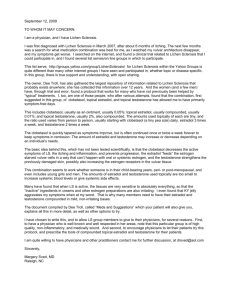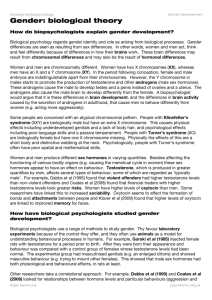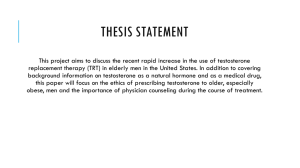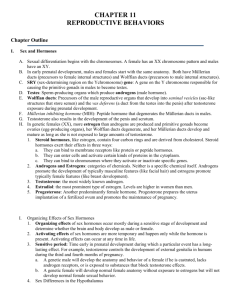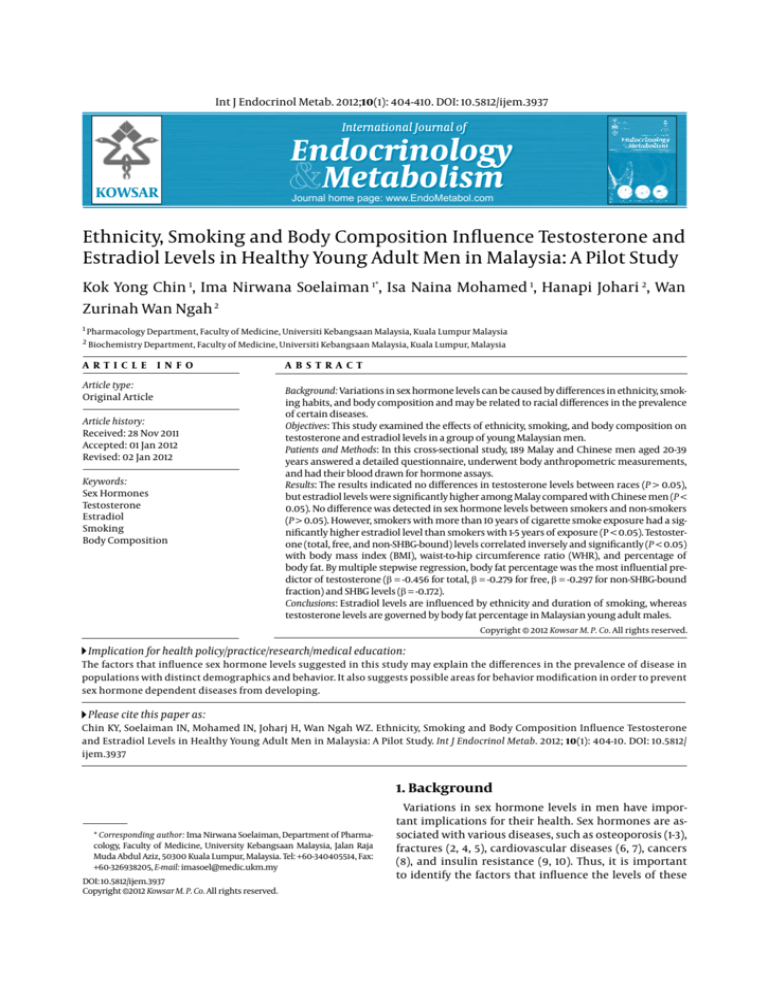
Int J Endocrinol Metab. 2012;10(1): 404-410. DOI: 10.5812/ijem.3937
International Journal of
KOWSAR
Endocrinology
Metabolism
Journal home page: www.EndoMetabol.com
Ethnicity, Smoking and Body Composition Influence Testosterone and
Estradiol Levels in Healthy Young Adult Men in Malaysia: A Pilot Study
Kok Yong Chin 1, Ima Nirwana Soelaiman 1*, Isa Naina Mohamed 1, Hanapi Johari 2, Wan
Zurinah Wan Ngah 2
1 Pharmacology Department, Faculty of Medicine, Universiti Kebangsaan Malaysia, Kuala Lumpur Malaysia
2 Biochemistry Department, Faculty of Medicine, Universiti Kebangsaan Malaysia, Kuala Lumpur, Malaysia
A R T I C LE
I NFO
Article type:
Original Article
Article history:
Received: 28 Nov 2011
Accepted: 01 Jan 2012
Revised: 02 Jan 2012
Keywords:
Sex Hormones
Testosterone
Estradiol
Smoking
Body Composition
AB S TRAC T
Background: Variations in sex hormone levels can be caused by differences in ethnicity, smoking habits, and body composition and may be related to racial differences in the prevalence
of certain diseases.
Objectives: This study examined the effects of ethnicity, smoking, and body composition on
testosterone and estradiol levels in a group of young Malaysian men.
Patients and Methods: In this cross-sectional study, 189 Malay and Chinese men aged 20-39
years answered a detailed questionnaire, underwent body anthropometric measurements,
and had their blood drawn for hormone assays.
Results: The results indicated no differences in testosterone levels between races (P > 0.05),
but estradiol levels were significantly higher among Malay compared with Chinese men (P <
0.05). No difference was detected in sex hormone levels between smokers and non-smokers
(P > 0.05). However, smokers with more than 10 years of cigarette smoke exposure had a significantly higher estradiol level than smokers with 1-5 years of exposure (P < 0.05). Testosterone (total, free, and non-SHBG-bound) levels correlated inversely and significantly (P < 0.05)
with body mass index (BMI), waist-to-hip circumference ratio (WHR), and percentage of
body fat. By multiple stepwise regression, body fat percentage was the most influential predictor of testosterone (β = -0.456 for total, β = -0.279 for free, β = -0.297 for non-SHBG-bound
fraction) and SHBG levels (β = -0.172).
Conclusions: Estradiol levels are influenced by ethnicity and duration of smoking, whereas
testosterone levels are governed by body fat percentage in Malaysian young adult males.
Copyright
c
2012 Kowsar M. P. Co. All rights reserved.
Implication for health policy/practice/research/medical education:
The factors that influence sex hormone levels suggested in this study may explain the differences in the prevalence of disease in
populations with distinct demographics and behavior. It also suggests possible areas for behavior modification in order to prevent
sex hormone dependent diseases from developing.
Please cite this paper as:
Chin KY, Soelaiman IN, Mohamed IN, Joharj H, Wan Ngah WZ. Ethnicity, Smoking and Body Composition Influence Testosterone
and Estradiol Levels in Healthy Young Adult Men in Malaysia: A Pilot Study. Int J Endocrinol Metab. 2012; 10(1): 404-10. DOI: 10.5812/
ijem.3937
1. Background
* Corresponding author: Ima Nirwana Soelaiman, Department of Pharmacology, Faculty of Medicine, University Kebangsaan Malaysia, Jalan Raja
Muda Abdul Aziz, 50300 Kuala Lumpur, Malaysia. Tel: +60-340405514, Fax:
+60-326938205, E-mail: imasoel@medic.ukm.my
DOI: 10.5812/ijem.3937
Copyright c 2012 Kowsar M. P. Co. All rights reserved.
Variations in sex hormone levels in men have important implications for their health. Sex hormones are associated with various diseases, such as osteoporosis (1-3),
fractures (2, 4, 5), cardiovascular diseases (6, 7), cancers
(8), and insulin resistance (9, 10). Thus, it is important
to identify the factors that influence the levels of these
Chin KY et al. 405
Sex Hormones in Young Men
hormones, which can explain the differences in the
prevalence of diseases in populations with distinct demographics and behaviors. Furthermore, if the factors
that are associated with alterations in sex hormones are
avoidable (such as smoking and obesity), behavior modifications can be initiated early to prevent diseases from
developing later in.
Previous studies have indicated that ethnicity contributes to variations in sex hormone levels in a population.
A large international study by Orwell et al. (2010) noted
considerable differences in sex hormone levels in elderly
men of various ethnic and geographical backgrounds
(11). In most other studies, comparisons have been made
between African-Americans and Caucasians (12, 13). The
2010 census revealed that the Malaysian population consists of Malays (67.4%), Chinese (24.6%), Indians (7.3%),
and other minorities (0.7%) (http://www.statistics.gov.
my), but the differences between Asian ethnic groups
that live in the same country, such as Malaysia, have not
been examined. In this study, Malays and Chinese were
selected for comparison, because they are the 2 largest
ethnic groups in Malaysia.
Smoking is a potential confounding factor that contributes to variations in sex hormone levels. No consensus
has been reached regarding the effect of smoking on sex
hormones, wherein reduced (14), elevated (15-17), and
constant (18-20) levels of testosterone in smokers versus
non-smokers have been reported. Further, smoking has
been associated with cardiovascular disease (21), which
is also linked to alterations in sex hormone levels (6, 7).
Body composition, especially adiposity, causes variations in sex hormones levels in men. Adiposity has been
linked to insulin resistance, which is also associated with
alterations in sex hormones (10). Previous studies have
used waist circumference or waist-to-hip circumference
ratio (WHR) (22) and body mass index (BMI) (23, 24) to
assess adiposity. We sought to confirm these studies using a novel and simple technique, based on bioelectrical
impedance, to determine the percentage of body fat and
WHR in subjects.
oxidative, nutritional, and bone health status of Malay
and Chinese men residing in the urbanized central part
of peninsular Malaysia. It was a cross-sectional study, for
which a purposive sampling method was adopted, as described (25). Briefly, subjects were recruited via advertisements in major newspapers, flyers, radio broadcasts, and
public announcements at various community centers
and mosques. The selection criteria were stated clearly in
the advertisements. Subjects were advised to bring their
medical reports, and a qualified physician screened the
subjects, based on a medical history and physical examination. The study was approved by the Ethics Committee
of Universiti Kebangsaan Malaysia Medical Centre (UKMMC).
2. Objectives
Subjects were categorized as smokers, ex-smokers, and
non-smokers. A smoker was defined as a person who had
been smoking daily and was still doing so at the time of
the examination; an ex-smoker had been smoking but had
ceased doing so for the past 6 months; and a non-smoker
was a person who had never smoked. Smokers were asked
to record their duration of smoking in years (27).
The objective of this study was to determine the effects
of ethnicity, smoking, and body composition on sex
hormone levels in a group of Malaysian men aged 20-39
years. Currently, there is no literature on the differences
in sex hormone levels between ethnic groups in Malaysia
or the factors that contribute to such variation. Young
adults were enrolled as subjects to determine whether
differences in ethnicity, smoking, and body composition
influence sex hormone levels in early adulthood.
3. Patients and Methods
3.1. Study Design
This study was conducted as a part of the Malaysian Aging Male Study, which aimed to examine the hormonal,
3.2. Subjects
The recruitment was conducted from January 2011 to
June 2011. Two hundred six Malaysian men of Chinese
and Malay ethnicity aged 20-39 years who resided in the
central region of peninsular Malaysia (Kuala Lumpur,
Gombak, and Klang) were recruited. The 20-39-year age
range was defined as ‘young adult,’ because other studies in Malaysia have referred to ‘middle-age’ as those
aged 40 years and above (26). All information pertaining to this study was explained to them, and written
informed consent was obtained. They were screened using a detailed questionnaire. Their medical history was
taken, and a physical examination was performed by
an experienced physician. The exclusion criteria for the
subjects were the same as those of the Malaysian Aging
Male Study, in which persons who suffered from chronic
diseases that affected major systems of the body, such
as hormonal abnormalities, osteoporosis, cardiovascular diseases, and cancers, were excluded, because these
diseases are associated with alterations in sex hormone
levels. Subjects who were taking long-term medications
were also excluded, because they could have affected sex
hormone levels.
3.3. Smoking Habits
3.4. Body Composition
The standing height of subjects without shoes was
measured using a portable stadiometer and recorded
to the nearest 0.1 cm. The weight of the subjects in light
clothing without shoes was recorded to the nearest 0.1
kg. Body mass index of subjects was calculated per the
formula: BMI (kg/m2) = body weight (kg) / (height x
Int J Endocrinol Metab. 2012;10(1):404-410
406
Chin KY et al.
Sex Hormones in Young Men
height) (m2). Waist circumference was measured using
a soft measuring tape midway between the lowest rib
margin and the iliac crest in the standing position. Hip
circumference was measured over the widest part of the
gluteal region. The waist-hip circumference ratio (WHR)
was then calculated.
The percentage of body fat was estimated using a
BC-418 Segmental Body Composition Analyzer (Tanita,
Illinois, USA). Estimation of body fat was based on the
principle of bioelectrical impedance using a constant
current source with high-frequency current (50 kHz,
500 A). The subjects were required to step on the platform, touch the electrodes with their bare feet, and
maintain a stable standing position. They were also
requested to grab handgrips while the impedance was
measured. The electric current flowed through their
bodies via electrodes at the toes of both feet and the fingertips of both hands. Voltage was measured at the heel
of both feet and the thenar side of both hands. The fat
in the body does not allow electricity to pass through,
whereas water in the muscle tissue does. The degree of
difficulty with which the electricity passed was used to
infer the percentage of body fat.
3.5. Measurement of Sex Hormones
All subjects were requested to fast for at least 8 hours
prior to attending the data collection session. During
the fasting period, they were allowed to consume only
water. Venipuncture was performed between 900 and
1030. Their blood was collected in plain tubes, and serum
was extracted. Part of the serum was sent immediately
to measure testosterone, estradiol, and albumin, and
the remaining serum was stored in polypropylene tubes
at -70°C for sex hormone-binding globulin (SHBG) measurements. The serum was stored 0-3 months.
Total testosterone and total estradiol levels were measured using the ADVIA Centaur (Siemens Healthcare
Diagnostics, Illinois, USA), based on competitive immunoassay with direct chemiluminescent technology.
Non-SHBG-bound and free fractions of sex hormones
were calculated per Södergård et al. (1982) (28). The albumin level was measured using the ADVIA 2400 (Siemens
Healthcare Diagnostics, Illinois, USA), based on a colorimetric method (bromcresol green method). SHBG level
was determined using solid phase enzyme-linked immunosorbent assay (ELISA) kits, based on the sandwich
principle (IBL International, Hamburg, Germany). The
test principles and procedures were performed per the
manufacturers. The interassay coefficient of variation
(CV) for the total testosterone, total estradiol, albumin,
and SHBG assays were 1.79%-6.32%, 1.99%-2.03%, 1.37%-1.70%,
and 7.2%-11.6%, respectively
and as median [interquartile range (IQR) ] if the distribution was skewed. Normality of the data was examined
by Kolmogorov-Smirnov test. Transformation for skewed
data was attempted, and normalized values were used
for statistical analysis. If transformation did not improve the normality of the data, non-parametric tests
were used to analyze them. Differences between Chinese
and Malay men were analyzed by independent t-test for
normal data and Mann-Whitney U test for skewed data.
Similarly, differences between smokers and non-smokers were analyzed independent t-test for normal data
and Mann-Whitney U test for skewed data. Smokers were
stratified into 3 groups according to how long they had
smoked: 1-5 years, > 5-10 years and > 10 years. Differences
between groups were compared by one-way analysis of
variance (ANOVA) for normal data and Kruskal-Wallis test
for skewed data.
Correlations between all parameters were examined
using Pearson’s correlation for normal data and Spearman’s correlation for skewed data. The strength of the
correlation was indicated by Pearson’s correlation coefficient (r) or Spearman’s correlation coefficient (rs).
Multiple regression analysis was used to evaluate the
relationship between each sex hormone and individual
anthropometric parameters (BMI, WHR, percentage of
body fat). Standardized regression coefficient (β) was
used to compare the contribution of each predictor in
the regression model, describing the extent of SD change
in sex hormones when the predictors of interest changed
by 1 SD while the other predictors were held constant. R2
of the equation was also shown to indicate the percentage of variation in sex hormones that could be explained
by the equations that were generated. The statistical significance was set to P < 0.05. The results were analyzed
using SPSS for Windows, version 16.0 (SPSS Inc., Chicago,
Illinois).
4. Results
Two hundred six Chinese and Malay men aged 20-39
years volunteered for this study. One hundred eightynine (91.75%) successfully underwent all the necessary
screens and completed the required questionnaires,
body composition assessments, and venipuncture. Seventeen subjects were excluded—3 men did not complete
the questionnaire, and 14 men failed to visit for a comTable 1. Demographic and Anthropometric Characteristics of Subjects
Malay
(99)
The values for sex hormones were expressed as mean
[standard deviation (SD) ] if the distribution was normal
Overall
(189)
Age b, y
25.6 ± 5.5
30.1 ±5.7a
27.8 ± 6.0
Height b, cm
167.7 ± 5.8
171.2 ± 5.8 a
169.4 ± 6.0
Weight b, kg
66.8 ± 13.6
70.9 ±17.7
68.7 ± 14.7
23.7 ± 4.3
24.1 ± 4.7
23.9 ± 4.5
BMI
3.6. Data Analysis
Chinese
(90)
b, kg/m2
Waist to hip ratio b
0.87 ± 0.06 0.89 ± 0.05 a 0.88 ± 0.05
Body fat b, %
20.6 ± 6.5
21.0 ± 6.6)
20.8 ± 6.5
a Indicates significant difference between the Chinese and Malay men.
b Data are Presented as Mean ± SD
Int J Endocrinol Metab. 2012;10(1):404-410
Chin KY et al. 407
Sex Hormones in Young Men
plete blood test. Ninety-nine (52.4%) subjects were Malay,
and 90 (47.6%) were Chinese men. Their mean age was
27.8 years (SD = 6.0 years) (Table 1).
All testosterone levels were tested normal in terms of
normality (Kolmogorov-Smirnov test with P > 0.05), but
all estradiol and SHBG levels were skewed. Transformations (square root, log 10, inverse) were attempted, but
they only improved the skewness, not the kurtosis of the
estradiol levels. Hence, they were analyzed using nonparametric tests. The distribution of SHBG reverted to
normal after square root transformation was attempted
and was used in the data analysis.
There was a significant difference in age and height (P <
0.05) between Malays and Chinese; the Chinese were older and taller. The Chinese also had significantly higher
WHRs (P < 0.05) compared with Malays. No other significant differences in body anthropometry were observed
between the groups (Table 1). The differences in total, free,
and non-SHBG-bound testosterone between the Chinese
and Malays were not significant (P > 0.05). However, significant differences (P > 0.05) in the total, free, and nonSHBG estradiol levels were noted between groups, attributed to estradiol levels alone rather than SHBG levels,
because there was no significant difference (P < 0.05) in
SHBG levels between the groups (Table 2).
Sixty-three subjects were smokers, and 116 were nonsmokers. Seven subjects identified themselves as exsmokers, and 3 chose not to disclose their smoking
habits. Only the data of smokers and non-smokers were
included in this analysis. No significant differences (P >
0.05) were observed in any hormone between smokers
and non-smokers (Table 2).
Smokers were stratified according to how long they
smoked [1-5 years (n = 16), > 5-10 years (n = 22) and more
than 10 years (n = 29) ], and differences in hormone levels were examined. No significant difference (P < 0.05) in
total, free, or non-SHBG-bound testosterone; non-SHBGbound estradiol; or SHBG was noted. Differences in total
estradiol and free estradiol between groups were marginally significant (P = 0.035 for total estradiol, P = 0.043
for free estradiol). Subjects with a history of smoking of
more than 10 years had significantly higher (P < 0.05) total and free estradiol levels than subjects with 1-5 years of
smoking history (Table 2).
Bivariate correlation analysis revealed significant negative correlations (P < 0.05) between total testosterone
and weight, BMI, percentage of body fat, and WHR, although the strength of the correlations was moderate.
Similarly, significant negative correlations (P < 0.05)
were observed between free and non-SHBG-bound testosterone with weight, BMI, percentage of body fat, and
WHR, but the strength of the correlation was smaller
than the correlation with total testosterone. On adjusting for age, the significance between WHR and all testosterone levels was lost (P > 0.05).
Total estradiol correlated negatively and significantly
with BMI, WHR, and percentage of body fat, but the
strength of the correlations was small. Free and nonSHBG-bound free estradiol did not correlate with any anthropometric parameter. SHBG correlated significantly
(P < 0.05) with all anthropometric parameters, and the
significance persisted after adjustments for age (Table 3).
When BMI, WHR, and percentage of body fat were selected as predictors of testosterone (total, free and bioavailable) and SHBG (transformed) in the stepwise regression
analysis, the percentage of body fat was determined to
be the most influential predictor for each of the equations, explained 20.8% of the variation in total testoster-
Table 2.Testosterone, Estradiol and SHBG Levels of the Subjects According to Ethnicity, Smoking Status and Duration of Exposure to Cigarette Smoke.
Smoking Status
Duration of Exposure to Cigarette Smoke
Malay
Ethnicity
Chinese
Overall
Non-Smoker Smoker
1-5 Years
> 5-10 Years
> 10 Years
20.4 ± 6.4
19.3 ± 6.4
19.9 ± 6.4
19.9 ± 6.2
20.1 ± 6.9
19.5 ± 4.9
22.0 ± 8.4
18.7 ± 6.1
Free testosterone c,
nmol/L
0.43 ± 0.12
0.42 ± 0.12
0.43 ± 0.12
0.43 ± 0.12
0.43 ± 0.13
0.41 ± 0.11
0.46 ± 0.15
0.40 ± 0.11
Non-SHBG bound
testosterone c,
nmol/L
12.6 ± 3.5
12.1 ± 3.6
12.4 ± 3.6
12.6 ± 3.6
12.3 ± 3.5
11.9 ± 3.1
13.4 ± 4.1
11.5 ± 3.0
Total estradiol,
pmol/L, IQR
120.0 ± 74.0
65.5 ± 111.3 a
104.0 ± 96.5 115.5 ± 92.3
86.0 ± 103.0 147.5 ± 86.0
86.5 ± 103.0
75.0 ± 97.5 b
Free estradiol,
pmol/L, IQR
2.74 ± 2.02
1.74 ± 2.57 a
2.55 ± 2.41
2.67 ± 2.37
2.18 ± 2.36
3.57 ± 2.06
2.23 ± 2.16
1.75 ± 2.09 b
Non-SHBG bound
estradiol, pmol/L,
IQR
85.1 ± 60.2
51.1 ± 81.4 a
73.9 ± 74.0
84.4 ± 72.5
64.7 ± 76.3
108.9 ± 66.5
63.4 ± 65.5
50.9 ± 60.5
Sex-hormone
binding globulin,
nmol/L, IQR
36.4 ± 22.8
32.9 ± 22.7
35.5 ± 22.4
31.4 ± 21.5
37.3 ± 25.8
37.6 ± 23.9
38.6 ± 21.1
36.6 ± 27.9
Total testosterone
nmol/L
c,
a Indicates significant difference between the Malays and the Chinese
b Indicates significant difference between smokers with more than 10 years of exposure and smokers with 1-5 years of exposure.
c Data are Presented as Mean ± SD
Int J Endocrinol Metab. 2012;10(1):404-410
408
Chin KY et al.
Sex Hormones in Young Men
Table 3. Correlation Between Sex Hormones and Anthropometric Parameters
Height
Weight
BMI, kg/m2
Body fat
WHR
0.057
0.057
-0.362 b
-0.314 b
-0.423 b
-0.41 b
-0.456 b
-0.375 b
-0.413 b
-0.248 b
0.063
0.062
-0.193 b
-0.13
-0.233 b
-0.207 b
-0.278 b
-0.164 c
-0.262 b
-0.119
0.068
0.068
-0.208 b
-0.127
-0.251 b
-0.204 b
-0.296 b
-0.163 c
-0.273 b
-0.097
Unadjusted
0.079
-0.134
-0.174 c
-0.176 c
-0.144 c
Adjusted for age
no nonparametric alternative
-0.069
-0.077
-0.055
-0.080
-0.086
-0.065
-0.459 b
-0.496 b
-0.448 b
-0.480 b
-0.284 b
-0.261 b
Total testosterone, nmol/L
Unadjusted
Adjusted for age
Free testosterone, nmol/L
Unadjusted
Adjusted for age
Non-SHBG bound testosterone, nmol/L
Unadjusted
Adjusted for age
Total estradiol, pmol/L a
Free estradiol, pmol/L a
Unadjusted
0.066
Adjusted for age
no nonparametric alternative
-0.040
Non-SHBG bound estradiol,
pmol/L a
Unadjusted
0.064
Adjusted for age
no nonparametric alternative
-0.051
Sex-hormone binding globulin, nmol/L
Unadjusted
Adjusted for age
-0.023
-0.039
-0.414 b
-0.461 b
a Indicates skewed data and the correlation coefficients are presented in Spearman’s rho while the rest is presented in Pearson’s r
b Indicates significance with P < 0.01
c Indicates significance with P < 0.05.
Table 4. Standardized Regression Coefficient (β) and r2 for Each of the Model Elicited.
Predictor Included
Predictor Excluded
Body Fat, %
BMI, kg/m2
WHR
-0.456
0.208 a
-0.026
-0.053
-0.279
0.078 a
0.132
-0.064
-0.297
0.088 a
0.125
-0.058
-0.172
0.030 a
0.151
0.032
Total Testosterone
βb
r 2 c model
Free Testosterone
βb
r 2 c model
Non-SHBG bound testosterone
βb
r 2 c model
SHBG (square root of)
βb
r 2 c model
a Significance with P < 0.001
b Standardized regression coefficient (β) describes the extent of SD change of the sex hormones when the predictors of interest change by 1 SD while
the other predictors are held constant.
c r2 of the equation is also shown to indicate the percentage of variation in sex hormones that can be explained by the equations generated.
one, 7.8% of the variation of free testosterone, 8.8% of the
variation in bioavailable testosterone, and 3.0% of the
variation in SHBG. Regression analysis was not conducted for estradiol levels, because the data were not distributed normally and because there was no nonparametric
alternative (Table 4).
5. Discussion
Ethnic differences in the prevalence and incidence of
diseases, such as diabetes mellitus (29), prostate cancer
(30), and hip fractures (31), have been observed in Malaysia. For instance, according to the National Cancer Registry 2007, the Chinese population has a higher prevalence
Int J Endocrinol Metab. 2012;10(1):404-410
Chin KY et al. 409
Sex Hormones in Young Men
of prostate cancer compared with other ethnic groups
in Malaysia (30). Because these diseases are associated
with sex hormones, their prevalence may be attributed
to variations of these hormones between races. Other
factors, such as smoking (15, 17) and obesity (22), should
be taken into consideration, because they can also influence the levels of sex hormones in the body. However, the
relationship between sex hormones and potential confounding factors has not been examined in the Malaysian
population. The difference in testosterone levels between
Chinese and Malay ethnic groups in Malaysia was not
significant in this study, but the difference in estradiol
levels was significant. Because these ethnic groups have
not been compared, we do not have reference data for our
findings. However, a similar observation was reported
by Rohrmann et al. (2007), wherein serum estrogen levels were significantly higher in non-Hispanic black men
compared with non-Hispanic white men in the United
States (12). Determining whether this difference in estradiol levels explains the difference in the prevalence of
diseases is beyond the scope of the present study. However, Malay men have a lower incidence of hip fractures
compared with Chinese men in Malaysia (31). This may
be attributed to the positive effects of estradiol in achieving higher peak bone mass during early adulthood. Since
estradiol is produced largely by the conversion of endogenous testosterone by aromatase in men (32), the difference in estradiol levels between Malay and Chinese men
may reflect a difference in the expression of this enzyme.
Diet can contribute to variations in sex hormones; thus,
the difference in estradiol levels could also have been
caused by distinct food intake patterns between groups
(16, 33). Both factors need further study to explain the difference in estradiol levels between the two ethnicities.
Our finding of the lack of effect of smoking on sex hormone levels in apparently healthy young adult men is
supported by several studies. Klaiber and Broverman
(1988) found no significant difference in testosterone
production rate or metabolic clearance rate of testosterone between smokers and non-smokers. They also
recorded a significantly higher level of estradiol and its
production rate in smokers versus non-smokers (20).
Hautanen et al. also failed to note any differences in
testosterone and estradiol levels in a mixed population
of healthy subjects, dyslipidemic subjects, and subjects
with heart disease (19). Harman et al. found no significant effect of smoking on total and free testosterone
indices in men over a wide age range (18). There are
other studies that indicate a higher testosterone level
in smokers compared with non-smokers (15-17). The discrepancy between our results and the previous studies
may be due to differences in the study populations (age
range, ethnicity, and geographical variation) and the
duration of exposure. Few studies with relatively small
sample sizes have reported significantly lower testosterone levels in smokers versus non-smokers (14). Also,
testosterone level is negatively associated with waist
circumference/waist-hip circumference ratio and body
fat. A previous study by van de Beld et al. (2000) in older
males found a significant inverse relationship between
fat mass and testosterone levels but not estradiol levels
(34). Our findings not only confirm these findings but
also imply that the influence of body adiposity on testosterone in men begins in early adulthood. This was
confirmed by a study by Mauras et al. (1998), wherein
decreased lipid oxidation and increased fat mass developed when the hypogonadal state was artificially
induced in a group of young men (35), explaining why
low testosterone and obesity are associated with many
diseases, such as insulin resistance (10).
In our study, BMI did not correlate with any sex hormone level, perhaps because it is not an accurate estimation of adiposity, in which lean mass and fat mass are not
differentiated. This causes men with muscular builds
and low body fat to have high BMIs (36).
There are several limitations of this study. The subjects
were not randomly selected; thus, selection bias hinders
the generalization of our findings. The use of bioelectric
impedance technology to estimate the percentage of total body fat did not reflect the distribution of body fat in
each body part, but it is the most feasible body fat estimation technique in mobile data collection and is a better
measurement of adiposity compared with BMI (36). The
effect of passive smoking was not evaluated in this study,
which could have influenced sex hormone levels in men
and thus should be considered in future studies. Since
this was a pilot study, a larger sample size would increase
the power of the study and the validity of the results.
In conclusion, testosterone levels in young adult men
in Malaysia are not influenced by ethnicity or smoking,
but estradiol levels are higher in Malays and smokers
with more than 10 years of exposure. Percentage of body
fat is the most significant predictor of testosterone and
SHBG. The results indicate that the percentage of body
fat, ethnicity, and duration of exposure to cigarette
smoke influence sex hormones and should be taken into
consideration in the interpretation of sex hormone levels in future studies.
Acknowledgements
We would like to thank Universiti Kebangsaan Malaysia for providing financial support for this study and the
Pharmacoepidemiology Unit, Department of Pharmacology, Faculty of Medicine, Universiti Kebangsaan Malaysia
for providing statistical consultation.
Financial Disclosure
None declared.
Funding/Support
This study was supported by Arus Perdana Grant (UKMAP-TKP-09-2009) and postgraduate research fund (FF-3762010) provided by Universiti Kebangsaan Malaysia.
Int J Endocrinol Metab. 2012;10(1):404-410
410
Chin KY et al.
Sex Hormones in Young Men
References
1.
2.
3.
4.
5.
6.
7.
8.
9.
10.
11.
12.
13.
14.
15.
16.
17.
18.
Araujo AB, Travison TG, Leder BZ, McKinlay JB. Correlations between serum testosterone, estradiol, and sex hormone-binding
globulin and bone mineral density in a diverse sample of men. J
Clin Endocrinol Metab. 2008;93 (6) :2135-41.
Kuchuk NO, van Schoor NM, Pluijm SM, Smit JH, de Ronde W,
Lips P. The association of sex hormone levels with quantitative
ultrasound, bone mineral density, bone turnover and osteoporotic fractures in older men and women. Clin Endocrinol (Oxf).
2007;67 (2) :295-303.
Paller CJ, Shiels MS, Rohrmann S, Basaria S, Rifai N, Nelson W,
et al. Relationship of sex steroid hormones with bone mineral
density (BMD) in a nationally representative sample of men. Clin
Endocrinol (Oxf). 2009;70 (1) :26-34.
LeBlanc ES, Nielson CM, Marshall LM, Lapidus JA, Barrett-Connor
E, Ensrud KE, et al. The effects of serum testosterone, estradiol,
and sex hormone binding globulin levels on fracture risk in
older men. J Clin Endocrinol Metab. 2009;94 (9) :3337-46.
Meier C, Nguyen TV, Handelsman DJ, Schindler C, Kushnir MM,
Rockwood AL, et al. Endogenous sex hormones and incident
fracture risk in older men: the Dubbo Osteoporosis Epidemiology Study. Arch Intern Med. 2008;168 (1) :47-54.
Svartberg J, von Muhlen D, Mathiesen E, Joakimsen O, Bonaa KH,
Stensland-Bugge E. Low testosterone levels are associated with
carotid atherosclerosis in men. J Intern Med. 2006;259 (6) :576-82.
Yeap BB, Hyde Z, Almeida OP, Norman PE, Chubb SA, Jamrozik
K, et al. Lower testosterone levels predict incident stroke and
transient ischemic attack in older men. J Clin Endocrinol Metab.
2009;94 (7) :2353-9.
Gann PH, Hennekens CH, Ma J, Longcope C, Stampfer MJ. Prospective study of sex hormone levels and risk of prostate cancer.
J Natl Cancer Inst. 1996;88 (16) :1118-26.
Grossmann M, Thomas MC, Panagiotopoulos S, Sharpe K, Macisaac RJ, Clarke S, et al. Low testosterone levels are common and
associated with insulin resistance in men with diabetes. J Clin
Endocrinol Metab. 2008;93 (5) :1834-40.
Tsai EC, Matsumoto AM, Fujimoto WY, Boyko EJ. Association of
bioavailable, free, and total testosterone with insulin resistance:
influence of sex hormone-binding globulin and body fat. Diabetes Care. 2004;27 (4) :861-8.
Orwoll ES, Nielson CM, Labrie F, Barrett-Connor E, Cauley JA,
Cummings SR, et al. Evidence for geographical and racial variation in serum sex steroid levels in older men. J Clin Endocrinol
Metab. 2010;95 (10) :E151-60.
Rohrmann S, Nelson WG, Rifai N, Brown TR, Dobs A, Kanarek N,
et al. Serum estrogen, but not testosterone, levels differ between
black and white men in a nationally representative sample of
Americans. J Clin Endocrinol Metab. 2007;92 (7) :2519-25.
Winters SJ, Brufsky A, Weissfeld J, Trump DL, Dyky MA, Hadeed
V. Testosterone, sex hormone-binding globulin, and body composition in young adult African American and Caucasian men.
Metabolism. 2001;50 (10) :1242-7.
Shaarawy M, Mahmoud KZ. Endocrine profile and semen characteristics in male smokers. Fertil Steril. 1982;38 (2) :255-7.
English KM, Pugh PJ, Parry H, Scutt NE, Channer KS, Jones TH. Effect of cigarette smoking on levels of bioavailable testosterone
in healthy men. Clin Sci (Lond). 2001;100 (6) :661-5.
Field AE, Colditz GA, Willett WC, Longcope C, McKinlay JB. The relation of smoking, age, relative weight, and dietary intake to serum adrenal steroids, sex hormones, and sex hormone-binding
globulin in middle-aged men. J Clin Endocrinol Metab. 1994;79 (5)
:1310-6.
Svartberg J, Jorde R. Endogenous testosterone levels and smoking in men. The fifth Tromso study. Int J Androl. 2007;30 (3) :13743.
Harman SM, Metter EJ, Tobin JD, Pearson J, Blackman MR. Lon-
gitudinal effects of aging on serum total and free testosterone
levels in healthy men. Baltimore Longitudinal Study of Aging. J
Clin Endocrinol Metab. 2001;86 (2) :724-31.
19. Hautanen A, Manttari M, Kupari M, Sarna S, Manninen V, Frick
MH, et al. Cigarette smoking is associated with elevated adrenal
androgen response to adrenocorticotropin. J Steroid Biochem
Mol Biol. 1993;46 (2) :245-51.
20. Klaiber EL, Broverman DM. Dynamics of estradiol and testosterone and seminal fluid indexes in smokers and nonsmokers.
Fertil Steril. 1988;50 (4) :630-4.
21. Ambrose JA, Barua RS. The pathophysiology of cigarette smoking and cardiovascular disease: an update. J Am Coll Cardiol.
2004;43 (10) :1731-7.
22. Svartberg J, von Muhlen D, Sundsfjord J, Jorde R. Waist circumference and testosterone levels in community dwelling men.
The Tromso study. Eur J Epidemiol. 2004;19 (7) :657-63.
23. Bjornerem A, Straume B, Midtby M, Fonnebo V, Sundsfjord J,
Svartberg J, et al. Endogenous sex hormones in relation to age,
sex, lifestyle factors, and chronic diseases in a general population: the Tromso Study. J Clin Endocrinol Metab. 2004;89 (12)
:6039-47.
24. Orwoll E, Lambert LC, Marshall LM, Phipps K, Blank J, BarrettConnor E, et al. Testosterone and estradiol among older men. J
Clin Endocrinol Metab. 2006;91 (4) :1336-44.
25. Chin KY, Ima-Nirwana S, Isa Naina M, Norazlina M, Ahmad Nazrun S, Norliza M, et al. Calcaneal Quantitative Ultrasound Value
for Middle-Aged and Elderly Malaysian Chinese Men and Its Association With Age and Body Anthropometry. J Clin Densitom.
2012;15(1):86-91.
26. Karim NA, Kather HM. Nutritional Status and Food Habits of
Middle-aged Adults in Selected Areas of Selangor. Malays J Nutr.
2003;9(2) :125-36.
27. Keddissi JI, Younis WG, Chbeir EA, Daher NN, Dernaika TA, Kinasewitz GT. The use of statins and lung function in current and
former smokers. Chest. 2007;132 (6) :1764-71.
28. Sodergard R, Backstrom T, Shanbhag V, Carstensen H. Calculation of free and bound fractions of testosterone and estradiol-17
beta to human plasma proteins at body temperature. J Steroid
Biochem. 1982;16 (6) :801-10.
29. Letchuman GR, Wan Nazaimoon WM, Wan Mohamad WB, Chandran LR, Tee GH, Jamaiyah H, et al. Prevalence of diabetes in the
Malaysian National Health Morbidity Survey III 2006. Med J Malaysia. 2010;65 (3) :180-6.
30. Gerard LCC, Halimah Y. Second report of the national cancer
Registry cancer incidence in malaysia. In: Malaysia MoH, editor.
Kuala Lumpur; 2003.
31. Lee J-K, Khir ASM. The incidence of hip fracture in Malaysians
above 50 years of age: variation in different ethnic groups.
APLAR Journal of Rheumatology. 2007;10 (4) :300-5.
32. Riggs BL, Khosla S, Melton LJ, 3rd. Sex steroids and the construction and conservation of the adult skeleton. Endocr Rev. 2002;23
(3) :279-302.
33. Longcope C, Feldman HA, McKinlay JB, Araujo AB. Diet and sex
hormone-binding globulin. J Clin Endocrinol Metab. 2000;85 (1)
:293-6.
34. van den Beld AW, de Jong FH, Grobbee DE, Pols HA, Lamberts
SW. Measures of bioavailable serum testosterone and estradiol
and their relationships with muscle strength, bone density,
and body composition in elderly men. J Clin Endocrinol Metab.
2000;85 (9) :3276-82.
35. Mauras N, Hayes V, Welch S, Rini A, Helgeson K, Dokler M, et al.
Testosterone deficiency in young men: marked alterations in
whole body protein kinetics, strength, and adiposity. J Clin Endocrinol Metab. 1998;83 (6) :1886-92.
36. Snijder MB, van Dam RM, Visser M, Seidell JC. What aspects of
body fat are particularly hazardous and how do we measure
them? Int J Epidemiol. 2006;35 (1) :83-92.
Int J Endocrinol Metab. 2012;10(1):404-410

